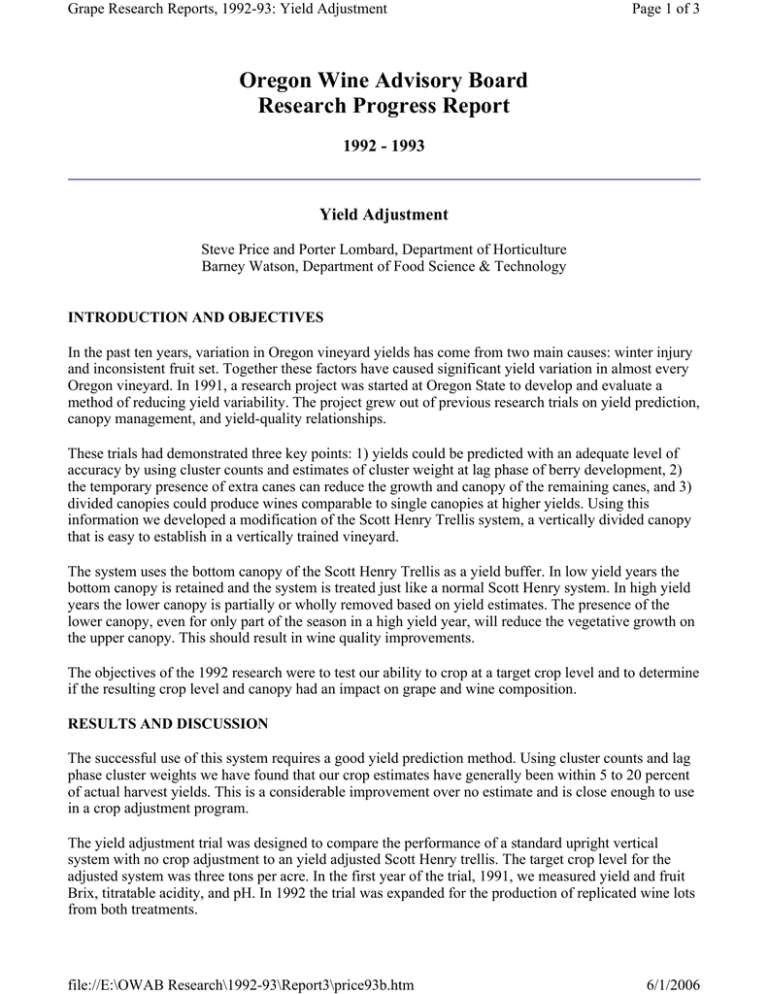Oregon Wine Advisory Board Research Progress Report 1992 - 1993 Yield Adjustment
advertisement

Grape Research Reports, 1992-93: Yield Adjustment Page 1 of 3 Oregon Wine Advisory Board Research Progress Report 1992 - 1993 Yield Adjustment Steve Price and Porter Lombard, Department of Horticulture Barney Watson, Department of Food Science & Technology INTRODUCTION AND OBJECTIVES In the past ten years, variation in Oregon vineyard yields has come from two main causes: winter injury and inconsistent fruit set. Together these factors have caused significant yield variation in almost every Oregon vineyard. In 1991, a research project was started at Oregon State to develop and evaluate a method of reducing yield variability. The project grew out of previous research trials on yield prediction, canopy management, and yield-quality relationships. These trials had demonstrated three key points: 1) yields could be predicted with an adequate level of accuracy by using cluster counts and estimates of cluster weight at lag phase of berry development, 2) the temporary presence of extra canes can reduce the growth and canopy of the remaining canes, and 3) divided canopies could produce wines comparable to single canopies at higher yields. Using this information we developed a modification of the Scott Henry Trellis system, a vertically divided canopy that is easy to establish in a vertically trained vineyard. The system uses the bottom canopy of the Scott Henry Trellis as a yield buffer. In low yield years the bottom canopy is retained and the system is treated just like a normal Scott Henry system. In high yield years the lower canopy is partially or wholly removed based on yield estimates. The presence of the lower canopy, even for only part of the season in a high yield year, will reduce the vegetative growth on the upper canopy. This should result in wine quality improvements. The objectives of the 1992 research were to test our ability to crop at a target crop level and to determine if the resulting crop level and canopy had an impact on grape and wine composition. RESULTS AND DISCUSSION The successful use of this system requires a good yield prediction method. Using cluster counts and lag phase cluster weights we have found that our crop estimates have generally been within 5 to 20 percent of actual harvest yields. This is a considerable improvement over no estimate and is close enough to use in a crop adjustment program. The yield adjustment trial was designed to compare the performance of a standard upright vertical system with no crop adjustment to an yield adjusted Scott Henry trellis. The target crop level for the adjusted system was three tons per acre. In the first year of the trial, 1991, we measured yield and fruit Brix, titratable acidity, and pH. In 1992 the trial was expanded for the production of replicated wine lots from both treatments. file://E:\OWAB Research\1992-93\Report3\price93b.htm 6/1/2006 Grape Research Reports, 1992-93: Yield Adjustment Page 2 of 3 The yield results of the first two years are shown in Figure 1. The yield data from earlier years are presented to show the magnitude of yield variation that has occurred in the block over the last six years. The yield adjusted system came quite close to the target level of three tons per acre each year. The crop on the adjusted treatment was within 10 percent of the target in 1991 and within 3 percent of the target in 1992. In 1991, the vines in the experiment were damaged by low winter temperatures and the control vines cropped at only 1.7 tons per acre. On the adjusted system, part of the lower canopy was retained to compensate for the low crop and the crop level at harvest was 2.7 tons per acre. There was no injury in 1992 and the weather during bloom was warm. Cluster weights were high and control vines cropped at 3.43 tons per acre. On the adjusted system, all of the lower canopy was removed except for replacement shoots. The crop level on the adjusted system at harvest was 3.09 tons per acre. There were no significant differences in Brix, TA, or pH between the two canopies in 1991 or 1992. Wines from the adjusted system had seven percent higher anthocyanins and 12 percent higher total phenols than the control wines in 1992. The trial has so far demonstrated that yield variation can be predicted and then adjusted both up and down by the use of an adjustable canopy system. There appears to be a slight wine quality improvement this year. We have not shown that wine quality would improve in years when the adjusted system is cropped higher than the control, but previous research would suggest that it might. The trial is intended to run for at least two more years to determine if these results can be repeated. At this point we can only look back on the variation in the block for the last six years and think what would have happened if we had hit a crop level of three tons per acre each year. The total return from the adjusted system would have been higher than the control, the average annual return from an adjusted system would have been more consistent, and wine quality may have been less variable. Given the current uncertain state of the grape and wine market in Oregon, an improvement in yield and quality consistency should be a desirable goal. file://E:\OWAB Research\1992-93\Report3\price93b.htm 6/1/2006 Grape Research Reports, 1992-93: Yield Adjustment file://E:\OWAB Research\1992-93\Report3\price93b.htm Page 3 of 3 6/1/2006





